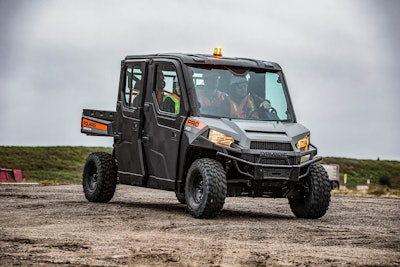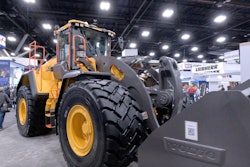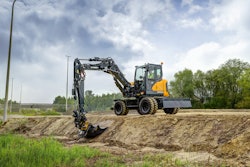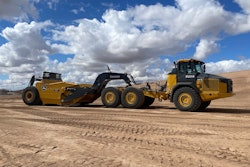
Editor's Note: This guest post was provided by Polaris.
Off-road operation is still at the core of utility vehicles – and with their evolution beyond purely recreational use, there are now even more options engineered for work.
Made to go where pick-up trucks can’t with similar capabilities, today’s UTVs are becoming the go-to workhorse across industries and jobsites. As operations increasingly prioritize efficiency and innovation, the evolution of the UTV continues to meet customer demands head-on with gas, diesel and electric options. But all UTVs aren’t built the same. So before adding one to your fleet, it’s important to consider the basics: work environment, jobsite requirements and vehicle features.
Reliability to Withstand the Jobsite
Construction sites are tough on vehicles. To raise the bar on jobsite durability, look for UTVs built with heavy-duty components that can withstand the consistent wear and tear of demanding environments. For example, tires made from heavy-duty, non-directional materials better handle sharp debris and rugged terrain, and Kevlar-backed vinyl seating to resist punctures and tears.
Additionally, sealed suspension systems and corrosion-resistant components will protect the vehicle from dirt, dust and moisture, reducing breakdowns and providing reliable operation day after day. For all-weather conditions, vehicles with enclosed cabs and climate control systems increase efficiency by allowing operations to continue in varying temperatures and weather conditions.
Pairing these robust components with easy-to-maintain machines further boosts vehicle reliability. UTVs with features like extended service intervals, fault alarms and universal parts will significantly lower the time and resources required for upkeep. Also check certified maintenance intervals, which can help cut in-field maintenance time and service costs.
Furthermore, standard warning alarms for service needs, like low oil pressure, belt slip and engine overheating, allow operation to be paused before a costly repair is needed, while easy access points provide efficient maintenance checks.
When looking to meet jobsite sustainability goals or environmental regulations, electric UTVs come standard with heavy-duty components just like the gas and diesel counterparts, while taking simplicity a step further with advanced drivetrains that require even less maintenance. Without engine-oil changes, spark plugs or clutch maintenance, servicing the vehicle has never been easier. On-board diagnostics further enhance efficiency by providing real-time updates on power use, battery status and motor temperature.
Capability to Meet the Work at Hand
Combining agility and heavy-duty capabilities, UTVs can increase jobsite productivity by offering high payload and towing capacity to transport materials, tools and crew more efficiently, especially in tight spaces.
When adding a UTV to a construction fleet, consider the power, payload and towing needs of the job.
Electric powertrains offer the same towing and cargo capacity as their gas-powered counterparts with the added advantage of instantaneous torque and precise handling. With a variety of battery options, some providing up to 45 miles of range, e-UTVs minimize downtime, ensuring they meet the needs of the jobsite while offering quieter, cleaner performance. (Actual range will vary based on conditions such as weather, cargo loads, rates of acceleration, vehicle maintenance, and vehicle usage.)
Standard Safety Features
Construction jobsites are full of hazards, making safety a top priority. When selecting a UTV for your fleet, ensure it is equipped with standard safety features that help promote jobsite safety, avoid mishaps and increase situational awareness. Vehicles with high-visibility, three-point seat belts, backup alarms and horns will help enhance operator safety while improving visibility on-site. Built-in speed limiting features also allow for adjustable driving speeds, helping crews comply with jobsite regulations.
Many UTVs also offer optional safety enhancements. For example, lightbars, strobe lights and side-view mirrors improve visibility, making them ideal for enhancing operator awareness while maintaining productivity on demanding worksites. Cab components like doors, windshields, and rear panels allow operators to work in dust, rain, or snow without sacrificing performance or comfort.
Work UTVs come standard with essential safety features, including high-visibility seat belts, horn and backup alarm, as well as speed-limiting capabilities.
E-UTVs offer additional advantages, including quieter operation, which improves situational awareness and facilitates easier crew communication, while the absence of combustible fuels opens up previously restricted areas for operation. By prioritizing safety features through thoughtful design and technology, gas and diesel-powered and electric UTVs offer peace of mind for operators and fleet managers.
Choosing the right UTV for a construction fleet requires balancing durability, maintenance, and productivity, while adhering to jobsite regulations. By prioritizing features that match specific use cases and jobsite challenges, a UTV becomes an invaluable asset, enhancing performance and driving operational success. In some cases, it may even replace the traditional pickup truck on the jobsite boosting productivity and delivering long-lasting value.
 Brady Lafrinere
Brady Lafrinere







